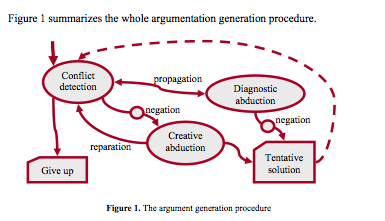A computational model of argumentation in everyday conversation: A problem-centred approach
Citation: Jean-Louis Dessalles (2008) A computational model of argumentation in everyday conversation: A problem-centred approach. Proceeding of the 2008 conference on Computational Models of Argument: Proceedings of COMMA 2008 (RSS)
Internet Archive Scholar (search for fulltext): A computational model of argumentation in everyday conversation: A problem-centred approach
Download: http://www.enst.fr/~jld/papiers/pap.conv/Dessalles 07111264.pdf
Tagged: argumentation (RSS), informal argumentation (RSS), state-change diagrams (RSS), dialogue (RSS), speech act theory (RSS)
Summary
The paper presents an argument generation procedure, which was implemented in Prolog. The computer program "is able to produce the same arguments as those observed in a variety of real dialogues, using a small number of steps."
Argumentation is a large part of conversation. This paper uses a corpus of 17 hours of family conversation, which breaks down as follows:
Conversation: 60% Conversation (inaudible): 13% Other (child screaming, songs): 5% Utilitarian (mainly negotiation about food offer): 11% Empty: 11%
The audible conversation (60% of the total corpus) breaks down as follows: 74% argumentative discussions 19% narratives 7% immediate events (see Table 1)
However, the paper does not define these items or explain how they were distinguished.
Then it proposes a human argumentation model (Figure 1), which supposes that arguments are local, taking a "knowledge-to-argument" (K2A) approach (see On the acceptability of arguments and its fundamental role in nonmonotonic reasoning, logic programming and n-person games).
Argumentation generation
Figure 1 presents the argument generation procedure 
Cognitive conflicts provoke the construction of arguments. A cognitive conflict is when a proposition is seen both positively and negatively (or in Dessalles terminology, has opposite 'strengths'). People form hunches (here referred to by the technical term, 'abduction'.
The model distinguishes diagnostic abduction--based on observation--from creative abduction; more clarity of this distinction would be useful.
Theoretical and Practical Relevance
Such a program might be useful for generating FAQ argument trees for online conversations; the program and further details of the procedure are not publicly available in any obvious place, but one could check with the author for more details.